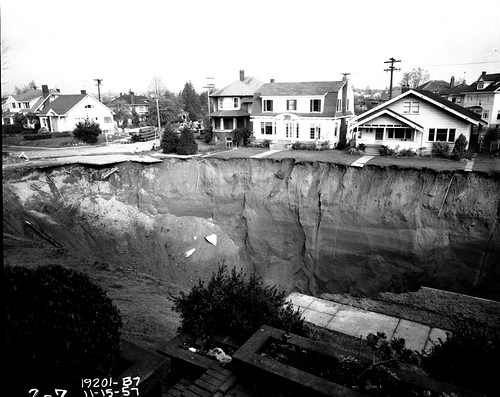Seattle’s Biggest Water Leak Disaster – and How it Could Be Prevented Now
Sinkholes can be life-threatening, as well as remarkably inconvenient–and expensive! We saw evidence of this twice recently in Florida, when huge craters swallowed first a Tampa homestead (and the homeowner), followed a few weeks later a sinkhole that gobbled up a 60-foot wide chunk of the Summer Bay resort in Clermont, near Disney World.
Neither of these holes compared in size with Seattle’s biggest sinkhole disaster, though, which occurred back in 1957 in the City’s Ravenna Boulevard. Thankfully, with modern methods of water leak detection, Seattle residents likely don’t need to worry about situations like this occurring again.
What Happens in Seattle..
What happens in Vegas stays in Vegas, right? Seattle wasn’t so lucky, however, and the whole world knew about the Ravenna Boulevard sinkhole within a matter of hours.
Here’s how it went down:
Nov 11, 1957:
- 11.30 pm: A water leak was reported in the then-50 year-old trunk sewer in Ravenna Boulevard, which was originally built atop quicksand.
- 12.30 am: Within the hour, the 6-foot high brick sewer tunnel caved in, causing a sinkhole to appear in the roadway above it. The crater eventually expanded to 175 feet wide, 200 feet long and 50 feet deep.
- 4.30 am: By this time, the city’s engineer had men and machines onsite, trying various methods to contain the damage. By then, 43,000 inhabitants had been cut off from sewer service – a state of affairs lasted almost two weeks!
Nov 22, 1957:
- Sewer service was finally restored to the area, 11 days later. Can you imagine 43,000 homes being without sewer facilities for that long? Ouch.
1959:
- Repairs to the tunnel were finally completed two years after the event.
The Ravenna sinkhole doesn’t make the list of the 25 biggest in history, but it certainly was the largest Seattle ever had to contend with. Amazingly, nobody was injured and although 10 homes were evacuated, none were damaged during the process.
Sinkhole Science
Sinkholes in urban areas happen most often as a result of broken water mains or collapsed sewers, which caused the Ravenna event. When the pipes give way the water leaks out into the earth and washes away the soil or dissolves the deposits of limestone or salt. It can happen gradually or suddenly.
When there’s no longer material supporting the surface, the rock dissolves and spaces and caverns develop underground. Sinkholes can penetrate as deep as 100 feet or more, or they can be just a few inches in depth.
Prevention is Better than Cure
It’s always better to try and avoid a sinkhole problem than to deal with it after the fact, and engineers now have ways of testing to detect the risk of underground cavities that could cause sinkholes such as the Ravenna Boulevard event. Preventing sinkholes in urban areas depends mostly on managing the ground water and the sewer system as efficiently as possible. The good news is that modern techniques offer a range of options for water leak detection that the Seattle engineers didn’t have back in 1957, such as ground-penetrating radar, seismography, camera inspections, thermal imaging and acoustic signal detection.
An Expensive Experience
The cost to repair the Ravenna sinkhole in 1957 to 1959 totalled $2 million, which is equal to $16 million when we convert into today’s currency using an online inflation calculator.
Seattle historian Feliks Banel says that repairs had to bypass a section of the sewer line, which involved building a 5,000-foot long bypass channel and filling it with earth and material. After that, they rebuilt the street and now there’s no trace that it ever happened, he says.
Fast Forward to the Future
If only the engineers had had access to today’s leak detection tools, Seattle might never have experienced the Ravenna sinkhole. Sure, there wouldn’t be a story to tell, but local residents probably agree that they would have been happy to lose out on that aspect.
Still, things have changed now; home and business owners undertake annual water leak surveys to look for problem areas and repair them before they become serious. Small, hidden leaks are identified quickly and repaired easily using non-destructive methods, long before they can present the risk of a sinkhole.
Avoiding disaster with water leak detection is far more practical in the long term than dealing with sinkholes, so make a point of having camera inspections on sewer lines at regular intervals, and keep a close eye on any water sources that seem to be running less than efficiently.
Image credit: Seattle Municipal Archives



